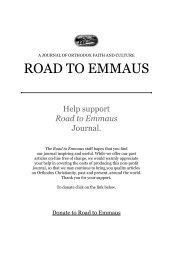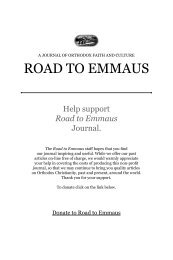RTE No 20 Interior - Road to Emmaus Journal
RTE No 20 Interior - Road to Emmaus Journal
RTE No 20 Interior - Road to Emmaus Journal
Create successful ePaper yourself
Turn your PDF publications into a flip-book with our unique Google optimized e-Paper software.
<strong>Road</strong> <strong>to</strong> <strong>Emmaus</strong> Vol. VIII, <strong>No</strong>. 4 (#31)FAITH UNSEENest in whether the miners spoke Greek or Turkish, as long as the mines wereproperly run and taxes were paid. Over time, the isolated Kromneans becamerelatively secure and, once the Hatti Humayun decree of 1856 granted a marginof <strong>to</strong>lerance, they were quick <strong>to</strong> establish Greek-speaking schools.Kromni was comprised of the following districts: Alithinos, Frangandon,Glouvena, Kodonandon, Loria, Mohora, Mantzandon, Nanak, Rakan,Roustandon, Sarandon, Samanandon, Sainandon, Tsahmanandon,Zeberekia, and several smaller villages. In the 1700s, despite a small openlyprofessedChristian population and the secure life and stable income of themines, there were no churches in Kromni. The ruins of a monastery that hadbeen destroyed at the time of the Persian invaders still s<strong>to</strong>od on Mount St.Zacharias, and the remains of an ancient church could be seen in the centerof Kromni, but under Turkish law, neither new churches could be built norold ones repaired. Strange <strong>to</strong> outward eyes, however, neither did this entireregion of “Muslims” have a single mosque, as if they were infidels.Yet there was no place that had as many secret churches as Kromni. Everyhouse had a tiny catacomb chapel in which the cryp<strong>to</strong>-Christians secretlyfulfilled their Christian duties, concealed from visiting Muslims and the fewOt<strong>to</strong>mans who lived with them as public servants and administra<strong>to</strong>rs.There were also other places of worship. For instance, near the village ofSarandon was a bush-covered hill with a secret entrance leading <strong>to</strong> a cavechurch,Krymentsa Panayia which they called “The Hidden Virgin.” Thechurch persevered there, undiscovered for centuries, inside the little hill.The cryp<strong>to</strong>-Christian house churches were normally underground and oneentered through a trap-door, from which steps led down in<strong>to</strong> the chapel. Thetrap-doors were hidden from view under fodder, or behind furniture or provisions.After dark, with curtains drawn and shutters closed, the floor coveringor furniture could be pulled back, and people would descend <strong>to</strong> pray. The iconcoveredwalls were lit by small oil lamps and beeswax candles, heavy with thescent of resin incense. It was here, in their own tiny catacomb churches, thatChristians gathered at night for services, prayers, and sacraments.The Pontian houses, called saray, were decorated outside with simpleblue geometrical designs or flowers. The cryp<strong>to</strong>-Christian houses were nodifferent from the seraya of real Ot<strong>to</strong>mans. They generally had two floors,the ground floor being the stable, on one side of which the animals werekept, while the other was generally used for s<strong>to</strong>rage. Inside this s<strong>to</strong>reroomwas the trap-door with steps leading <strong>to</strong> the secret chapel.In those days, the dress of both men and women was noble, the clothingof the Ot<strong>to</strong>man Orient. Men wore long, loose breeches that flowed out oneither side as they walked. A belt at the waist tied the long shirt <strong>to</strong> thebreeches, and a vest added dignity. During the winter, the men wore magnificen<strong>to</strong>vercoats and their heads were covered with fez or turbans.Women’s clothing varied from region <strong>to</strong> region, some rather European, othersmore eastern, and as one can see from old pictures, it was both beautifuland graceful. Even at the end of the 19th century, when the Kromneanswere able <strong>to</strong> publicly proclaim their Christianity and many of the men threwoff their Ot<strong>to</strong>man dress for the Greek Pontian zipkes (trousers), others continued<strong>to</strong> wear their Ot<strong>to</strong>man clothes, seeing in them a mark of dignity.Mullah MolasleymanThis was the time in which my grandmother’s great-great-grandfather lived.He was born in Ot<strong>to</strong>man Varenou on February 2, 1760, left Varenou when hewas sixteen and returned six years later, when he married and had a family.Of those six years, my grandmother Aphrodite only knew that he went first <strong>to</strong>Trebizond and then <strong>to</strong> Constantinople. When he returned <strong>to</strong> Varenou, however,he could read and write Turkish and Arabic, and could recite Arabictexts from the Koran with an ease unknown <strong>to</strong> the peasants in those years ofignorance and illiteracy. In a short time he became the hodja for the Muslimsof Varenou and the villages around Kromni. Although young, he was seriousand clever, and after a few years was the only person trusted <strong>to</strong> advise andadjudicate between the peasants of his area. He was known as MullahMolasleyman, and everyone respected him as a cleric and as a kadi (a judge). 5He was their native son, their own hodja. His knowledge of Turkish was agreat help <strong>to</strong> the villages, as he could communicate with the Turkish-speakingpublic officials sent <strong>to</strong> Kromni by the Ot<strong>to</strong>man rulers of Argyroupoli(<strong>to</strong>day’s Gümüshane), the district <strong>to</strong> which the villages of Kromni belong.Even in the 1700s, the Muslims of Kromni did not speak Turkish, but theso-called Greek Roméika, and the few Turkish families who settled thereafterwards forgot their Turkish within two or three generations. My grandmotherwas unable <strong>to</strong> explain how such things had happened, but answerednegatively when I asked her if these Muslims were Greeks (Romioi) who hadbecome Muslim by force. Although she was letter-perfect in our family his-5 Although like all cryp<strong>to</strong>-Christians he had a secret Christian name from baptism, we do not know what it was.1213










